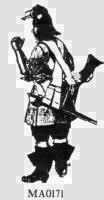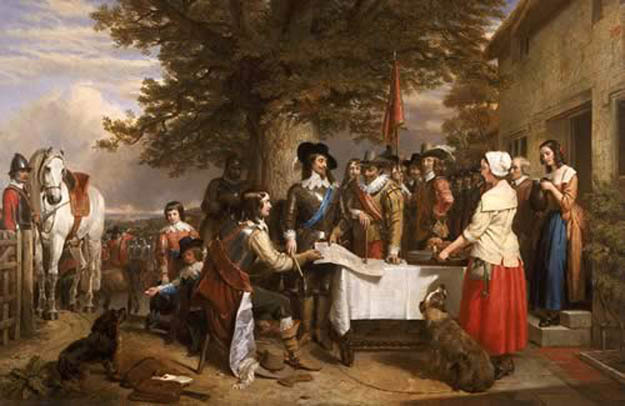 above upnaway figures, great guy
above upnaway figures, great guyThe reign of King Charles I. showed a widening of the difference between the ecclesiastic and puritan elements of the English community—elements which were the centres of the subsequently enlarged sections, royalist and parliamentarian.
 In the later dissentions between the King and the Commons it was early apparent how widespread had been the alienation of the people from the King’s cause—an alienation heightened, as Green in his “Short History”
In the later dissentions between the King and the Commons it was early apparent how widespread had been the alienation of the people from the King’s cause—an alienation heightened, as Green in his “Short History” tells us, by a fear that the spirit of Roman Catholicism, so victorious on the continent, should once more become dominant in England.
tells us, by a fear that the spirit of Roman Catholicism, so victorious on the continent, should once more become dominant in England.  How great was the tension may be known from the fact of the contemplated emigration to the American colonies of such leaders as Lord Saye and Sele, Lord Warwick,
How great was the tension may be known from the fact of the contemplated emigration to the American colonies of such leaders as Lord Saye and Sele, Lord Warwick,  Lord Brooke,
Lord Brooke,
and Sir John Hampden

(above Hamppden) and Oliver Cromwell.
 When the rupture at last came, the Parliament was found to have secured the larger arsenals, and also to have forces at its disposal in the trained bands of London and in the militia, which it was enabled rapidly to enrol
When the rupture at last came, the Parliament was found to have secured the larger arsenals, and also to have forces at its disposal in the trained bands of London and in the militia, which it was enabled rapidly to enrol.
 Though the unfurling of the Royal Standard near Nottingham failed to secure many adherents to the King’s cause, Essex hesitated to attack the royalists when they might have been easily dispersed, thinking no doubt to overawe the King by mere show of force
Though the unfurling of the Royal Standard near Nottingham failed to secure many adherents to the King’s cause, Essex hesitated to attack the royalists when they might have been easily dispersed, thinking no doubt to overawe the King by mere show of force.
 Yet when Charles began recruiting in the neighbourhood of Shrewsbury, he was soon able to gather an army, and on October 12th, 1642, he commenced his march upon London. The astute and carefully moderate policy of the Commons was to rescue the King from his surroundings, and to destroy the enemies, especially the foreign enemies, of the State, about the King’s person. The sanctity of the King’s person was yet a prominent factor—the belief in divinity of Kingship, notwithstanding all the misrule there had been, was yet alive in the hearts of the people. Therefore when the King had gathered his forces together and began his Southward march, Lord Essex with his army was commissioned “to march against his Majesties Army and fight with them, and to rescue the persons of the King, Prince and Duke of York.” The Earl of Essex, with the Parliamentarian forces, was at that time in Worcestershire, endeavouring to prevent the recruiting of the King’s troops; and though the Earl moved two days later on by rapid marches into Warwickshire, it was only to find that he had been out-marched by the King, who, after resting at Southam, stood with the Royalist army at Edgcot across the way to the capital. That this had been accomplished, notwithstanding the opposition of the strongholds of Warwick and Coventry, speaks not unfavourably for the generalship of Earl Lindsay, the King’s Lieutenant-General, whom we find at Edgcot contemplating an attack upon Banbury Castle.
Yet when Charles began recruiting in the neighbourhood of Shrewsbury, he was soon able to gather an army, and on October 12th, 1642, he commenced his march upon London. The astute and carefully moderate policy of the Commons was to rescue the King from his surroundings, and to destroy the enemies, especially the foreign enemies, of the State, about the King’s person. The sanctity of the King’s person was yet a prominent factor—the belief in divinity of Kingship, notwithstanding all the misrule there had been, was yet alive in the hearts of the people. Therefore when the King had gathered his forces together and began his Southward march, Lord Essex with his army was commissioned “to march against his Majesties Army and fight with them, and to rescue the persons of the King, Prince and Duke of York.” The Earl of Essex, with the Parliamentarian forces, was at that time in Worcestershire, endeavouring to prevent the recruiting of the King’s troops; and though the Earl moved two days later on by rapid marches into Warwickshire, it was only to find that he had been out-marched by the King, who, after resting at Southam, stood with the Royalist army at Edgcot across the way to the capital. That this had been accomplished, notwithstanding the opposition of the strongholds of Warwick and Coventry, speaks not unfavourably for the generalship of Earl Lindsay, the King’s Lieutenant-General, whom we find at Edgcot contemplating an attack upon Banbury Castle. 
Charles I held a council of war at Edgecote, about ten miles east of Edgehill on the day before the battle. The council was inconclusive because neither side knew where the other was. Indeed, they did not find out until that night when Royalist and Parliamentarian detachments both tried to find sleeping quarters in the same house at Wormleighton.
In this painting, Charles I stands immediately in front of the tree; Prince Rupert is seated; the Earl of Lindsey, the commander-in-chief, has his baton on the map; Sir Edmond Verney holds the king’s standard as he did on the battlefield and the two young princes, the future Charles II and James II, play with a dog on the left. Rupert’s self-assurance is shown by having him seated, even in the presence of the king. The bitter rivalry between him and Lindsey is demonstrated by the apparent confrontation between them, which the king is mediating.
The King’s was a good position: it commanded all the roads to London, held Banbury in its hand, covered the Cherwell bridge and fords, and had within touch the dominating escarpment of Edge Hill. If the purpose was the subjection of some prominent leaders of the Parliamentarians it succeeded only in the taking of Lord Saye and Sele’s house at Broughton, and of Banbury, and Banbury Castle; in the partial destruction of Lord Spencer’s house at Wormleighton, and in sending a summons to Warwick Castle to surrender.
Kineton, on October 22nd, was the headquarters of the Parliamentary army, the troops in the evening disposing themselves on the surrounding plain. “The common soldiers have not come into a bed, but lain in the open field in the wet and cold nights,” says the Worthy Divine “and most of them scarcely eat or drank at all for 24 hours together, nay, for 48, except fresh water when they could get it.” The want of transport, which had necessitated Hampden and struggling behind a day’s march in the rear in the neighbourhood of Stratford-on-Avon, had no doubt entailed these privations upon the army. Nor do the Royalists appear to have fared better, for Clarendon complains of the hostility of the country people, stating also that the circuit in which the battle was fought, being between the dominions of Lord Saye and Lord Brooke, was the most eminently corrupt of any in the kingdom. The King’s forces seem to have been quartered about the country between Wormleighton and Cropredy, Prince Rupert with his cavalry near Wormleighton, the King himself staying at Edgcot House, whilst the main body of the army occupied the slopes and high lands on the Northamptonshire side of the Cherwell vale near by.
The King’s forces seem to have been quartered about the country between Wormleighton and Cropredy, Prince Rupert with his cavalry near Wormleighton, the King himself staying at Edgcot House, whilst the main body of the army occupied the slopes and high lands on the Northamptonshire side of the Cherwell vale near by.  Thus the three roads North of Banbury were dominated by the Royalist troops, and the fourth, the old London road, was within striking distance.
Thus the three roads North of Banbury were dominated by the Royalist troops, and the fourth, the old London road, was within striking distance.  bennosfigures great blog
bennosfigures great blog
 The King’s forces seem to have been quartered about the country between Wormleighton and Cropredy, Prince Rupert with his cavalry near Wormleighton, the King himself staying at Edgcot House, whilst the main body of the army occupied the slopes and high lands on the Northamptonshire side of the Cherwell vale near by.
The King’s forces seem to have been quartered about the country between Wormleighton and Cropredy, Prince Rupert with his cavalry near Wormleighton, the King himself staying at Edgcot House, whilst the main body of the army occupied the slopes and high lands on the Northamptonshire side of the Cherwell vale near by.  Thus the three roads North of Banbury were dominated by the Royalist troops, and the fourth, the old London road, was within striking distance.
Thus the three roads North of Banbury were dominated by the Royalist troops, and the fourth, the old London road, was within striking distance.  bennosfigures great blog
bennosfigures great blog
No comments:
Post a Comment